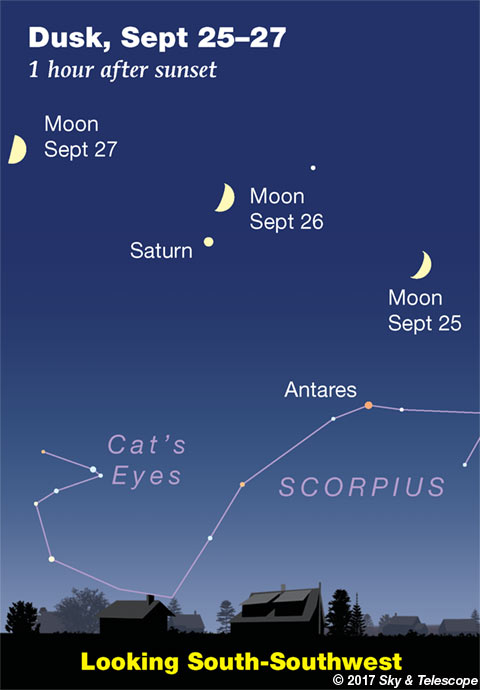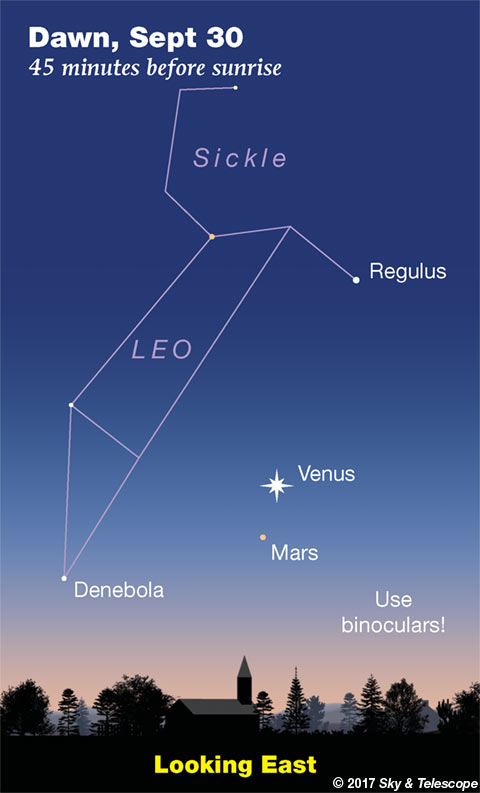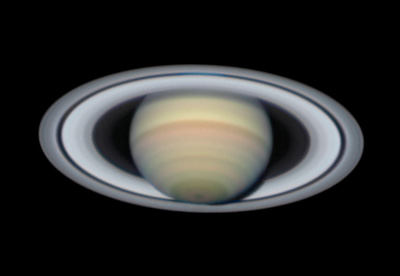Friday, September 22
• Low in the west-southwest during twilight, spot the thin waxing crescent Moon. Can you see Jupiter to the lower right of it, by about 7°? (for North America.)
• Equinox: Autumn begins in the Northern Hemisphere, and spring in the Southern Hemisphere, at 4:02 p.m. EDT. This is when the Sun crosses the equator (both Earth's equator and the celestial equator) heading south for the season.
• Coincidentally, every year around when summer turns to autumn, Deneb takes over from brighter Vega as the zenith star after nightfall (for skywatchers at mid-northern latitudes).
Saturday, September 23
• The starry W of Cassiopeia stands high in the northeast after dark. The right-hand side of the W (the brightest side) is tilted up. Down below it, Perseus is climbing up from the horizon.
• Saturn's brightest moon, Titan, stands about four ring-lengths to Saturn's west this evening. A small telescope will show it; look just after dark while Saturn is still fairly high. Titan circles Saturn every 16 days, so it takes 8 days to move east-west from one elongation to the other.
Sunday, September 24
• This is the time of year when the rich Cygnus Milky Way crosses the zenith in the hour after nightfall is complete (for skywatchers at mid-northern latitudes). The Milky Way now rises straight up from the southwest horizon, passed overhead, and runs straight down to the northeast.


Monday, September 25
• As twilight fades and the stars come out, the crescent Moon shines in the southwest. Look below or lower left of it, by about a fist-width at arm's length, for twinkly Antares. A similar distance or a bit more to the Moon's left, Saturn glows steadily.
Tuesday, September 26
• The "star" below or lower left of the Moon this evening is Saturn, 3,800 times farther away: Saturn is currently 85 light-minutes distant, compared to the Moon's 1.3 light-seconds.
Wednesday, September 27
• First-quarter Moon; exact at 10:54 p.m. EDT. Since we're still close to the equinox date, the almost exactly first-quarter Moon stands due south right at sunset. (Think about why!)
Then as night comes on, look to the Moon's lower right for Saturn, and to the Moon's lower left for the Sagittarius Teapot. Depending on where you are, a line lower left from the Moon will go right through the Teapot's centerline from the top of the lid through the center of the base.
Thursday, September 28
• Now the Moon shines above the Teapot's handle at nightfall.
Friday, September 29
• As the stars come out in late twilight, look high above the Moon for Altair. After dark, examine the sky about a fist at arm's length upper left of Altair for dim little Delphinus, the Dolphin. A little less far straight above Altair is smaller, dimmer Sagitta, the Arrow. (Binoculars will help.)
Saturday, September 30
• Arcturus shines in the west these evenings, sinking as twilight fades out. Equally-bright Capella is rising lower in the north-northeast, depending on your latitude. (The farther north you are the higher it will be.) They're both magnitude 0, as bright as Vega high overhead.
By mid- to late evening, Arcturus and Capella shine at identical heights. When will this happen? That depends on both your latitude and longitude.
When it happens, turn around and look low in the south-southeast (well to the lower left of the Moon). There will be 1st-magnitude Fomalhaut at the same height too — if you're at latitude 43° north. Seen from south of that latitude, Fomalhaut will be higher than Capella and Arcturus. Seen from north of there, it will be lower.
________________________
Want to become a better astronomer? Learn your way around the constellations! They're the key to locating everything fainter and deeper to hunt with binoculars or a telescope.
This is an outdoor nature hobby. For an easy-to-use constellation guide covering the whole evening sky, use the big monthly map in the center of each issue of Sky & Telescope, the essential guide to astronomy.

Once you get a telescope, to put it to good use you'll need a detailed, large-scale sky atlas (set of charts). The basic standard is the Pocket Sky Atlas (in either the original or Jumbo Edition), which shows stars to magnitude 7.6.
Next up is the larger and deeper Sky Atlas 2000.0, plotting stars to magnitude 8.5; nearly three times as many. The next up, once you know your way around, is the even larger Uranometria 2000.0 (stars to magnitude 9.75). And read how to use sky charts with a telescope.
You'll also want a good deep-sky guidebook, such as Sue French's Deep-Sky Wonders collection (which includes its own charts), Sky Atlas 2000.0 Companion by Strong and Sinnott, or the bigger Night Sky Observer's Guide by Kepple and Sanner.
Can a computerized telescope replace charts? Not for beginners, I don't think, and not on mounts and tripods that are less than top-quality mechanically (meaning heavy and expensive).
And as Terence Dickinson and Alan Dyer say in their Backyard Astronomer's Guide, "A full appreciation of the universe cannot come without developing the skills to find things in the sky and understanding how the sky works. This knowledge comes only by spending time under the stars with star maps in hand."
This Week's Planet Roundup

Mercury is disappearing into the glow of sunrise, farther to the lower left of bright Venus and faint Mars every morning.
Venus is the brilliant "Morning Star," (magnitude –3.9) low due east in the dawn. Every day it's sinking down lower toward Mars, and farther away from Regulus above it.
Mars, also low in the dawn, is magnitude +1.8, only 1/200th as bright as Venus. Use binoculars to look for it below or lower left of Venus. Their separation diminishes from 7° on the morning of the 23rd to 3° on the 30th (shown above). They'll pass closely by each other (¼° apart during dawn in the Americas) on October 5th.
Jupiter (magnitude –1.7) is disappearing into the sunset. Use binoculars or a low-power, wide-field scope to try for it just above the west-southwest horizon during bright twilight.
Saturn (magnitude +0.5, in Ophiuchus to the right of Sagittarius) glows in the south-southwest at dusk. Can you still find Antares twinkling 13° to Saturn's lower right? Get your telescope on Saturn early before it goes any lower!
Uranus (magnitude 5.7, in Pisces) and Neptune (magnitude 7.8, in Aquarius) are well up in the east and southeast, respectively, by mid- to late evening. Use our finder charts.
______________________
All descriptions that relate to your horizon — including the words up, down, right, and left — are written for the world's mid-northern latitudes. Descriptions that also depend on longitude (mainly Moon positions) are for North America.
Eastern Daylight Time (EDT) is Universal Time (UT, UTC, GMT, or Z time) minus 4 hours.
______________________
"This adventure is made possible by generations of searchers strictly adhering to a simple set of rules. Test ideas by experiments and observations. Build on those ideas that pass the test. Reject the ones that fail. Follow the evidence wherever it leads, and question everything. Accept these terms, and the cosmos is yours."
— Neil deGrasse Tyson, 2014
______________________
"Objective reality exists. Facts are often determinable. Carbon dioxide traps global heat. Vaccines save lives. Bacteria evolve to thwart antibiotics, because evolution. Science and reason are not a political conspiracy. They are how we discover reality. Civilization's survival depends on our ability, and willingness, to do so."
— Alan MacRobert, your Sky at a Glance editor
______________________
"Facts are stubborn things."
— John Adams, 1770
 3
3








Comments
Anthony Barreiro
September 22, 2017 at 5:00 pm
Big macho Venus? Delicate little Mars? Mythological gender bending!
You must be logged in to post a comment.
patrick-morton
September 23, 2017 at 10:52 pm
GREETINGS from Los Robles astronomy club in Venezuela, Thank you for such detailed maps with the real colours of the stars, It helps a lot in our astronomy classes.Thank you !!!
You must be logged in to post a comment.
Idrvbigtruks
September 24, 2017 at 11:52 pm
Im not excessively impressed with the saturn picture. I separated the rings with a 4 inch teloscope years ago. Is it harder to do now? I guess i took too much time off from star gazing, or had a better site to observe.
You must be logged in to post a comment.
You must be logged in to post a comment.